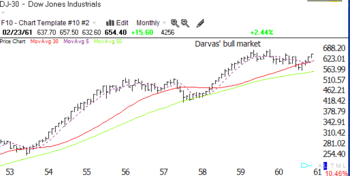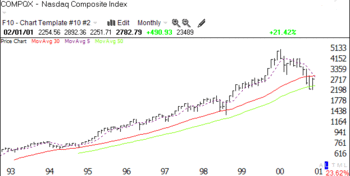The basic principles of my method are in fact quite simple:
Firstly, except in exceptional cases I only buy the stock of companies in new or developing industries, i.e., companies whose growth and earnings prospects look highly promising. I never buy stocks in established industries, in companies with huge capitalizations, or in companies which are already so big that the prospect of substantial growth is highly unlikely.
Secondly, having found such lively stocks, I certainly do not buy them straightaway. I first check the overall market trend to ascertain whether stocks in general are in an uptrend. I then check whether the stock belongs to a strong industry group, i.e., a group that is performing well in the market relative to other groups. Only when I have satisfied myself on these two points do I look in more detail at the stock that interests me.
Why all these precautions? Because I like to be sure that the odds are in my favor. If the market is in a downtrend, and the industry group is performing weakly I know that the cards are stacked against me and that my chances of making big profits are poorer than if the market and the industry are strong. You cannot be too careful in the stock market.
Having decided that the investment climate is right and that the industry is right I am ready to buy the particular stock if it is rising in price on volume. My basic principle of stock-market investment is that the only valid reason for buying a stock is that it is rising in price. If the price is rising no other reason is needed, if the price is not rising no other reasons are worth considering. I am not the slightest bit interested in explanations of why it is not behaving as it was expected to. I am only concerned with realities, on what is actually happening, not in conjectures, alibis, projections, rationalizations, and excuses.
Nicolas Darvas, “You Can Still Make It In The Market,” 1977, pp. 125-7.
Most of us cannot really explain the reasons for our success or failure when they are occurring, never mind years later. In the quote above, 20 years after he made his fortune (in his out of print book that I borrowed free through inter-library loan) Darvas tries to explain his trading strategy. It is really important for the reader to compare Darvas’ beliefs in the 1970’s about his approach, with the way he actually made money in the 1950’s, as he described it in his first book. There are important discrepancies.
In my strategy post on 4/23 I told you how important an influence Nicolas Darvas’ techniques were on my trading. While I learned a lot from him about buying stocks at all-time highs and ignoring brokers, investment letters and the media pundits, I failed to appreciate the importance of the general market trend to his trading success. In his first major book, printed in 1960 (see citation to right), Darvas described how he made two million dollars in the stock market in an 18 month period while he danced around the world. In this book, Darvas failed to stress the importance of the general market trend, as he did in the quote above. He used his “box system,” a form of support and resistance, to trade stocks and he emphasized that his method got him out of bear markets in advance, after a succession of failed trades. Outside of reacting to the performance of his trades when he would repeatedly get stopped out, Darvas did not appear to assess the direction of the market in advance, as he claims above.
Darvas also appears to be ambivalent regarding whether to buy stocks in a bear market. One of his first successful trades occurred when he bought the stock, Lorillard, when it showed strength in a weak market in 1957. “I felt I had sufficient proof of its strength, and I decided to become a bull in a bear market” (Darvas, reprinted in 1994, p.87). Darvas did not state that he checked out the tobacco industry to make sure it was behaving well. And in the reprinted edition of his book, in the section where he answers readers’ questions, Darvas says, “I also learned to stay out of bear markets unless my individual stocks remain in their boxes or advance (Darvas, 1994, p. 185). Thus, years later Darvas appeared willing to hold a strong stock in a bear market.
The large quote above was written by Darvas in 1977, after the huge bear market of 1974 and expresses his (revised ?) belief that he should be out of bear markets when the odds are against him. In his defense, Darvas might say that there is no confusion here. His method would simply get him out of bad markets when stocks that had broken out of the tops of their boxes, repeatedly fell back into their boxes. There is a difference, however, between a careful analysis of market trends before trading and determining the trend after trading. By the way, William O’Neil and David Ryan were fans of Darvas, and it should be no surprise that the CANSLIM approach bears a strong resemblance to the strategy described above by Darvas.
Rather than rely solely on Darvas’ recollections about his success, I thought it would be useful to see what the market was doing during the 18 months that Darvas made his fortune. Using TC2005, I found that in 1929, the Dow peaked at 386.10 and did not surpass that peak until 25 years later, in November 1954.  That rise peaked in April, 1956, at 524.40 and the market entered a slow decline that bottomed in October, 1957, at 416.27. It was after this bottom that Darvas began nibbling at stocks that would make him a fortune in 18 months. The subsequent bull market rise lasted through January, 1960 when it peaked at 688.20. Thus, in the period when Darvas made his fortune, the market was trading at all time highs in a bull market when the Dow increased 65%. This is not meant to belittle Darvas’ accomplishments–his portfolio increased much more than the market indexes. The critical point is that Darvas’ trading strategy worked in a major bull market with the Dow advancing toward all time highs. When the market reaches historic peaks, confidence and greed builds and traders can take stocks to extreme levels. We would not expect to achieve such spectacular gains in flat or slowly rising markets, which are well down from their historic peaks.
That rise peaked in April, 1956, at 524.40 and the market entered a slow decline that bottomed in October, 1957, at 416.27. It was after this bottom that Darvas began nibbling at stocks that would make him a fortune in 18 months. The subsequent bull market rise lasted through January, 1960 when it peaked at 688.20. Thus, in the period when Darvas made his fortune, the market was trading at all time highs in a bull market when the Dow increased 65%. This is not meant to belittle Darvas’ accomplishments–his portfolio increased much more than the market indexes. The critical point is that Darvas’ trading strategy worked in a major bull market with the Dow advancing toward all time highs. When the market reaches historic peaks, confidence and greed builds and traders can take stocks to extreme levels. We would not expect to achieve such spectacular gains in flat or slowly rising markets, which are well down from their historic peaks.
So, when did we have similar bull markets after Darvas? The market continued to a series of all-time peaks until a major top around 1,000 in 1966. This was a period during which William O’Neil made his money. The 1966 top was not decisively broken for 16 years. And then, from 1982 to 2,000 each new rise took the Dow to an all-time high. For example, during the extraordinary bull move in the Nasdaq Composite from 1995-2000, that index repeatedly went to historic peaks and yielded a 584% increase.  That is when the use of my Darvas and O’Neil inspired trading system helped me to multiply my IRA 14 fold. However, since their peaks in 2000, the Dow is down 12% and the Nasdaq Composite, 59%. We therefore should not expect to have achieved outstanding trading results using Darvas/O’Neil type techniques, since the top in 2000. Darvas may have got it right when he said the odds need to be in his favor before taking a position. Perhaps we growth stock traders should stay out of U.S. growth stocks until the market indexes reach historic peaks again–maybe in 2016. Think about it.
That is when the use of my Darvas and O’Neil inspired trading system helped me to multiply my IRA 14 fold. However, since their peaks in 2000, the Dow is down 12% and the Nasdaq Composite, 59%. We therefore should not expect to have achieved outstanding trading results using Darvas/O’Neil type techniques, since the top in 2000. Darvas may have got it right when he said the odds need to be in his favor before taking a position. Perhaps we growth stock traders should stay out of U.S. growth stocks until the market indexes reach historic peaks again–maybe in 2016. Think about it.
“Perhaps we growth stock traders should stay out of U.S. growth stocks until the market indexes reach historic peaks again–maybe in 2016. Think about it.”
Absurd! How is your broker going to profit from you following a rigid odds in your favor strategy? It simply won’t do. Ignore the man behind the curtain. Taser shares, anyone?
By the way, keep up the good work.
i enjoyed reading your comments, and i would like to continue doing this, but, i do not have your web address
can you send it to me,,,thank you
royalblue561@yahoo.com
The averages essentially got nowhere from 1969 – 1982 and you`re suggesting that the Darvas and Livermore methods won`t work well at all in this time frame. I believe you are wrong about your conclusion. Study some price charts during that time period and you will find some stocks hitting all time highs.
The U.S. stock exchanges are not the only stock exchanges in the world.China,India and many other countries have exploding stock prices why not apply Darvis system to other stock exchanges .Is anyone doing this? send reply to 711free@msn.com
Nice observation. It’s been in the back of my mind to verify the market direction during the massive gains by these renowned investors/traders. I just did another observation of the “Turtle Traders” who basically used the Darvas system from 1983-87 and the market was in a nice bull trend during that time too. The Turtle program was supposed to go to 1988, so thinking the crash of ’87 had something to do with it. It’s not specifically mentioned in either of the turtle books, but maybe alluded to when the program was terminated after Dennis took a big hit…
I’ll go one step farther than you. I believe the investment process for individual investors should be:
1) time the market: if it’s trending down (S&P 500 index below its 200-dma and MA trending down), go to cash; if trending up, buy stocks.
2) when trending up, follow industry rotation by the big money herd and buy the stocks in those industry groups with the highest volatility.